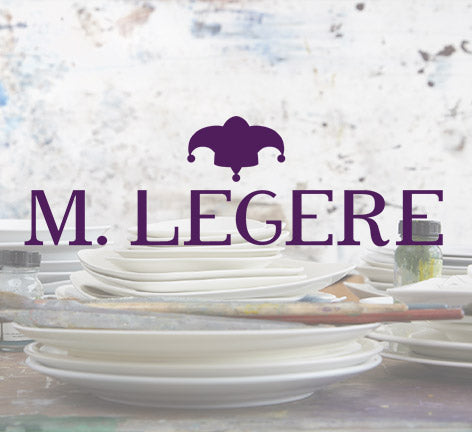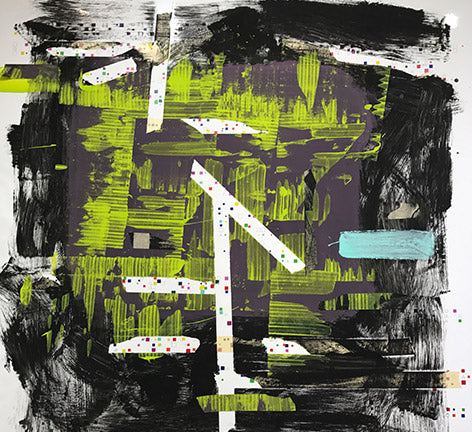About
Mark Legere
Founder

Photo Credit: Jen Fong
Mark is a passionate, cultural explorer who enjoys traveling to discover the distinctive and the rare. Whether at home in New York City or other major international art centers, Mark likes to seek out the most provocative artists, museums, and gallery exhibits. He is captivated by encountering the work of contemporary artists who are true originals, but may not yet be household names.
Though compelled by modern and contemporary art, Mark loves setting the stage for fun times shared at dinner parties full of good company, laughter, lively conversation, and, of course, good food and plentiful drink. Add to this mixture, art for the table and an “aha” moment sparks anticipation for the evening.
Mark created M. Legere combining his passion for art with his love of entertaining. Over the years, he has been drawn to bold ideas and the uncommon beauty of contemporary art, and has found these same art elements can also be brought to the table to create memorable evenings. His keen eye for quality and his warm hospitality can be found in everything M. Legere offers.
Mark personally chooses artists by a combination of responding to his sense of delight, looking at their educational achievement, and consulting astute local gallery owners, curators, art consultants, and art critics. He personally ensures that M. Legere only commissions work that resonates with original ideas and is created with exceptional skill.
The works of these artists speak equally to the layman, patron, as well as the collector. What is contemporary art? Who are these extraordinary artists? And how can their work be transported successfully onto dinnerware? See for yourself. Indeed, these creations are capable of giving people joy. There is a playfulness that is brought to the table that can withstand both the silliest and most intellectual of evenings.
Email Mark
M. Legere
Originals At The Table

Photo Credit: Jen Fong
Mark Legere founded M. Legere with a spark of artistic creativity interpreted through the eyes of a visionary in a pursuit to move the exciting artwork and ideas of contemporary artists off the wall and onto the party table. M. Legere has created a portfolio of artist-designed china to be celebrated and enjoyed with friends, guests, and family in modern dinner party and cocktail party settings. The artwork gives excitement to the table and an emotional boost to any cocktail gathering.
The designs are created by some of the most original artists in today's major urban art centers in North America and Europe - in particular New York City and re-energized Berlin. There is a difference between appealing artwork borne up by skill, stories and meaning, and the generic design intended for the widest consumer audience. These artists, instead of following the ordinary are here leading the tastes of tomorrow.
The select assemblage of the artists commissioned for M. Legere are all known, mostly market-approved entities familiar to anyone who follows contemporary art even casually. These artists possess resumes dotted with solo and group shows at galleries and museums here and in the EU. And the pieces bear the signature of each artist, much as Epiktetos of Attica, one of the most famous Greek plate and bowl painters did, between 529 and 490 BC.
The porcelain is created by a heritage manufacturing house in Limoges, France where skilled masters take control of natural elements, relying on secrets and skills that have been carefully honed by artisans since 1842. M. Legere is a purveyor of this unique mixture of contemporary art and the science of clay, having created a remarkable collaboration between commissioned contemporary artwork and the highest quality heritage porcelain.
Upon launching their exclusive products, M. Legere set the bar for relevant luxury in keeping with how modern consumers shop. M. Legere ignores the traditional norms and constraints of acquiring fine china, and instead offers distinctive and limited pieces suited to current entertaining.
Our Products

It is a common desire to rarify beautiful, fine objects and keep them on display as if in a museum but M. Legere wants great artwork to join the dinner party. These artists have reconfigured fine porcelain to be more relevant to the way people entertain by offering an artistic pluralism of dinnerware that, as artist-designed china, goes far beyond mere decoration.
Each artist has created artwork for a variety of plates, and one unusual bowl – an assortment essential for the contemporary dinner party. A place-setting is composed of three plates; a salad, dinner, and dessert plate, as well as a sleek and upwardly-poised bowl.
Small plates are the norm for larger groups celebrating and "milling-about" at cocktail parties throughout the year. M. Legere also offers the comfortably-sized appetizer/tapas/canapés/petit fours plate in a range of beautifully-created images from which to choose, ensuring a vibrant cocktail party setting.
All the contemporary art plates are created exclusively for M. Legere.
Owners of M. Legere pieces are imbued with a fine understanding of the history of aesthetic objects serving utilitarian purposes throughout the centuries; fine porcelain was created not simply to be a vessel to hold flowers, but to bloom in its own right. The tradition of presenting fine porcelain to the sophisticated consumer continues at M. Legere. Infusing beauty with functionality, M. Legere collection of dinnerware affords the discerning host the unique opportunity to introduce tantalizing contemporary art, usually reserved for gallery showings, onto the dinner party experience in an emotionally- evoking way. To possess a set of M. Legere dinnerware is to own a piece of contemporary art.
Limoges, France
Porcelain China Production

M. Legere has travelled to Limoges, France, to produce this reimagined collection of luxury porcelain. Limoges is renowned for its noble history and rich heritage in the decorative arts. Limoges is about tradition being practiced in the contemporary world. Porcelain production in Limoges dates back to the 1768 discovery of clay deposits with exceptional hardness and purity. Since that time, Limoges has supplied European royalty and aristocracy, and several American presidents with the epitome of quality and elegance. The French government has bestowed upon Limoges, France the honor of being named “Ville d’art et d’histoire” (City of Art and History). Located to the southwest of Paris and the northeast of Bordeaux, Limoges is an idyllic city founded by the Romans around 10 B.C. in what was ancient Gaul. Imagine a time when the amphitheater, forum, baths, and several temples to the gods typified the landscape.
Starting from the 11th century C.E., Limoges established itself as a flourishing artistic center. The famed St. Martial School of medieval music composition was centered in the local Abbey of Saint Martial. At about the same time, Limoges became noted for its production of high-quality enamel work. The discovery of kaolin, the principal ingredient in pure white hard paste clay, nearby Limoges in 1768, gave rise to Limoges as the principal region of France for the production of fine porcelain. Deriving its name from Kao-Ling, a village on a “high ridge” in the Jiangxi province of China, kaolin has long been regarded as “white gold” by the porcelain trade. While its use was relatively rare in France until that time, kaolin had been used by Chinese artisans in the creation of their rare and marvelous pieces for almost 2000 years. The magic and high quality of Limoges porcelain are reimagined in the M. Legere contemporary art dinnerware and cocktail collections.
HAVILAND, since 1842
World Renowned Heritage
The time-honored tradition of fine porcelain production continues in Limoges today.
M. Legere chose Haviland, Limoges’ leading heritage manufacturing house, as the exclusive manufacturer of his collection. Haviland has been carefully honing the craft since 1842. It is nothing short of magical to observe the alchemy of transmuting Limoges’ white clay into shining examples of luxury porcelain.
The legacy of generations of Haviland’s master craftsmen lies behind every distinctive piece of porcelain that bears the M. Legere insignia. Skilled artisans take hold of natural elements and precisely trim, smooth, dry, fire, glaze, embellish and fire the porcelain clay into objects of impeccable beauty and craftsmanship. When the curtain is pulled back, it is spellbinding to watch as the proud team of Haviland artisans precisely execute each required production stage. One is dazzled at seeing white clay take shape into recognizable pieces - ultimately becoming that distinctive piece of porcelain bearing the M. Legere insignia. Limoges porcelain made by Haviland is an expression of the exceptional art of living.
Learn More
Our Customers

The beautiful and provocative pieces of the M. Legere collection are sought after by distinctive customers around the globe who believe that there is a tremendous upside to collect provocative art and extraordinary pieces and are unafraid to enjoy the mixture of the elegant with the offbeat. Our customers are taste-makers, interested in product craftsmanship and place of production, and influenced by and appreciative of contemporary art.
Contemporary Art
Our questions to today’s artists are something like: what are you considering in your work; what are you trying to discover by your work; what are you striving for; and how have you presented that effort?
Today many artists often utilize “artistic investigations”; the artist uses his/her skills to create and augment knowledge. This “individualistic tinge” lacks the universal definitions of what is art, how one makes art today, and what we can expect to see and experience when we experience contemporary art creations. “If everyone goes off in different directions, there is no longer a direction toward which a narrative can point.” (Arthur C. Danto)
For ourselves, the spectators, we similarly ask questions: does the work draw you in; what is the work about; what is its content; what meaning might it embody; and how does it do that? We are liberated to enjoy art between the polars of figurative or representational art that is instantly recognizable from the known visible world, and wholly non-representational abstract art which visibly hides or bears no resemblance to any natural shapes or optical signs to our real life. When the work leaves the artist, the spectator decides its meaning. The artist does not control how the spectator interprets the work – the spectators rely on their own experience, emotions, knowledge and history to come to an interpretation or judgment of beauty. Maybe that is why the audience for contemporary art continues to grow.











